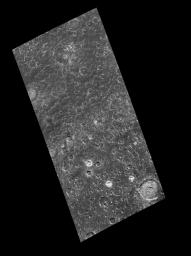
|
Heavy Cratering near Callisto’s South Pole
- Click the image above for a larger view
- Full-Res JPEG (800 x 1075) (83.2 kB)
- Full-Res TIFF (800 x 1075) (300.4 kB)
Caption:
Images from NASA's Galileo spacecraft provide new insights into this region near Callisto's south pole. This two frame mosaic shows a heavily cratered surface with smooth plains in the areas between craters. North is to the top of the image. The smoothness of the plains appears to increase toward the south pole, approximately 480 kilometers (293 miles) south of the bottom of the image. This smoothness of Callisto's surface was not evident in images taken during the 1979 flyby of NASA's Voyager spacecraft because the resolution was insufficient to show the effect. This smooth surface, and the process(es) that cause it, are among the most intriguing aspects of Callisto. Although not fully understood, the process(es) responsible for this smoothing could include erosion by tiny meteorites and energetic ions. Some craters, such as Keelut, the 47 kilometer (29 mile) crater in the lower right corner, have sharp, well defined rims. Keelut contains an inner ring surrounding a central depression about 17 kilometers (11 miles) in diameter. Keelut, and the more irregularly shaped, degraded Reginleif, the 32 kilometer (19.5 mile) crater in the top center of the image, are very shallow and have flat floors. Crater forms can be seen down to less than 2 kilometers (1.2 miles) in diameter in the image. Each picture element (pixel) in this image is approximately 0.68 kilometers (0.41 miles) across.
This image which was taken by the Galileo spacecraft's solid state imaging (CCD) system during its eighth orbit around Jupiter, on May 6th, 1997. The center of the image is located at 71.3 degrees south latitude, 97.6 degrees west longitude, and was taken when the spacecraft was approximately 35,470 kilometers (21,637 miles) from Callisto.
Background Info:
The Jet Propulsion Laboratory, Pasadena, CA manages the mission for NASA's Office of Space Science, Washington, DC.
This image and other images and data received from Galileo are posted on the World Wide Web, on the Galileo mission home page at URL http://galileo.jpl.nasa.gov. Background information and educational context for the images can be found at http://www.jpl.nasa.gov/galileo/sepo .
Cataloging Keywords:
| Name | Value | Additional Values |
|---|---|---|
| Target | Callisto | Jupiter |
| System | Jupiter | |
| Target Type | Satellite | Planet |
| Mission | Galileo | Voyager |
| Instrument Host | Galileo Orbiter | |
| Host Type | Orbiter | Flyby Spacecraft |
| Instrument | Solid-State Imaging (SSI) | |
| Detector | ||
| Extra Keywords | Crater, Grayscale | |
| Acquisition Date | ||
| Release Date | 1998-03-26 | |
| Date in Caption | ||
| Image Credit | NASA/JPL/ASU | |
| Source | photojournal.jpl.nasa.gov/catalog/PIA01221 | |
| Identifier | PIA01221 | |
